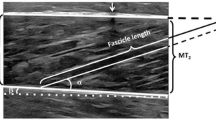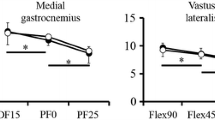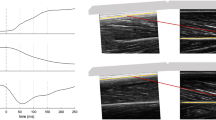Abstract
Purpose
The purpose of this study was to examine muscle fascicle properties of the gastrocnemius medialis (GM) during contraction and stretch between males and females. During contraction muscle fascicles shorten and pennation angles increase to generate force. Due to the elastic nature of the attached tendon, the fascicles continue to shorten when maximal force is achieved in order to sustain isometric force and this duration of fascicle shortening (DFS) can be observed with ultrasonography. Linear and curved muscle fascicles both display these kinetics; however, it is currently unknown if static stretch prior to a maximal voluntary contraction (MVC) alters the DFS and whether the effect differs between males and females.
Methods
Subjects performed an isometric MVC of the plantar flexors before and after a 2-min maximal dorsi-flexion stretch. Plantar flexor force was measured and ultrasound videography used to record GM and Achilles tendon architecture.
Results
Males were stronger than females (p = 0.004). The DFS was longer for females compared to males (p = 0.001) and the addition of a static stretch increased the DFS for curved (p = 0.002), but not linear, fascicles. Curved fascicles were longer (p = 0.05) with larger pennation angles (p = 0.04) for both males and females when compared to linear fascicles. Tendon excursion was greater (p = 0.05) post-stretch during contraction when compared to pre-stretch.
Conclusions
This study provides evidence that regardless of sex, curved muscle fascicles behave differently than linear fascicles and should be considered separately when muscle architecture is examined.




Similar content being viewed by others
Abbreviations
- 2D:
-
Two dimensional
- 3D:
-
Three dimensional
- ANOVA:
-
Analysis of variance
- AT:
-
Achilles tendon
- DFS:
-
Duration of fascicle shortening
- EMG:
-
Electromyography
- GL:
-
Gastrocnemius lateralis
- GM:
-
Gastrocnemius medialis
- Lf1:
-
Distance from deep aponeurosis to superficial aponeurosis
- Lf2:
-
Calculated length of fascicle
- Lf:
-
Full length
- MTJ:
-
Muscle tendon junction
- MTU:
-
Muscle tendon unit
- MVC:
-
Maximal voluntary contraction
- RMS:
-
Root mean square
- sol:
-
Soleus
- TA:
-
Tibialis anterior
References
Aagaard P, Simonsen EB, Andersen JL, Magnusson P, Dyhre-Poulsen P (2002) Increased rate of force development and neural drive of human skeletal muscle following resistance training. J Appl Physiol 9:1318–1326
Akagi R, Takahashi H (2014) Effect of a 5-week static stretching program on hardness of the gastrocnemius muscle. Scand J Med Sci Sports 24:950–957
Allen GM, McKenzie DK, Gandevia SC (1998) Twitch interpolation of the elbow flexor muscles at high forces. Muscle Nerve 21:318–328
Armstrong RB, Duan C, Delp MD, Hayes DA, Glenn GM, Allen GD (1993) Elevations in rat soleus muscle [Ca2+] with passive stretch. J Appl Physiol 74:2990–2997
Benard MR, Becher JG, Harlaar J, Huiging PA, Jaspers RT (2009) Anatomical information is needed in ultrasound imaging of muscles to avoid potentially substantial errors in measurement of muscle geometry. Muscle Nerve 39:652–665
Bolsterlee B, Veeger HEJ, van der Helm FCT, Gandevia SC, Herbert RD (2015) Comparison of measurements of medial gastrocnemius architectural parameters from ultrasound and diffusion tensor images. J Biomech 48:1133–1140
Bryant AL, Clark RA, Bartold S, Murphy A, Bennell KL, Hohmann E, Crossley KM (2008) Effects of estrogen on the mechanical behavior of the human Achilles tendon in vivo. J Appl Physiol 105:1035–1043
Chow RS, Medri MK, Martin DC, Leekam RN, Agur AM, McKee NH (2000) Sonographic studies of human soleus and gastrocnemius muscle architecture: gender variability. Eur J Appl Physiol 82:236–244
Fowles JR, Sale DG, MacDougall JD (2000) Reduced strength after passive stretch of the human plantarflexors. J Appl Physiol 89:1179–1188
Freriks B, Hermens H, Disselhorst-Klug C, Rau G (1999) The recommendations for sensors and sensor placement procedures for surface electromyography. Seniam 8:13–54
Fukashiro S, Komi PV, Järvinen M, Miyashita M (1995) In vivo achilles tendon loading during jumping in humans. Eur J Appl Physiol Occup Physiol 71:453–458
Fukunaga T, Kawakami Y, Kuno S, Funato K, Fukashiro S (1997) Muscle architecture and function in humans. J Biomech 30:457–463
Griffiths RI (1991) Shortening of muscle fibres during stretch of the active cat medial gastrocnemius muscle: the role of tendon compliance. J Physiol 436:219–236
Herbert RD, Clarke J, Kwah LK, Diong J, Martin J, Clarke EC, Gandevia SC (2011) In vivo passive mechanical behaviour of muscle fascicles and tendons in human gastrocnemius muscle–tendon units. J Physiol 589:5257–5267
Ichinose Y, Kawakami Y, Ito M, Kanehisa H, Fukunaga T (2000) In vivo estimation of contraction velocity of human vastus lateralis muscle during “isokinetic” action. J Appl Physiol 88:851–856
Jakobi JM, Rice CL, Curtin SV, Marsh GD (2001) Neuromuscular properties and fatigue in older men following acute creatine supplementation. Eur J Appl Physiol 84:321–328
Kawakami Y, Ichinose Y, Fukunaga T (1998) Architectural and functional features of human triceps surae muscles during contraction. J Appl Physiol 85:398–404
Kay AD, Blazevich AJ (2009) Isometric contractions reduce plantar flexor moment, Achilles tendon stiffness, and neuromuscular activity but remove the subsequent effects of stretch. J Appl Physiol 107:1181–1189
Kokkonen J, Nelson AG, Cornwell A (1998) Acute muscle stretching inhibits maximal strength performance. Res Q Exerc Sport 69:411–415
Kubo K, Kanehisa H, Kawakami Y, Fukunaga T (2001) Influence of static stretching on viscoelastic properties of human tendon structures in vivo. J Appl Physiol 90:520–527
Kubo K, Kanehisa H, Fukunaga T (2002) Effect of stretching training on the viscoelastic properties of human tendon structures in vivo. J Appl Physiol 92:595–601
Kurihara T, Oda T, Chino K, Kanehisa H, Fukunaga T, Kawakami Y (2005) Use of three-dimensional ultrasonography for the analysis of fascicle length of human gastrocnemius muscle during contractions. Int J Sport Sci Health 3:226–234
Kwah LK, Pinto RZ, Diong J, Herbert RD (2013) Reliability and validity of ultrasound measurements of muscle fascicle length and pennation in humans: a systematic review. J Appl Physiol 114:761–769
Leiber RL, Friden J (2000) Function and clinical significance of skeletal muscle architecture. Muscle Nerve 23:1647–1666
Lichtwark GA, Bougoulias K, Wilson AM (2007) Muscle fascicle and series elastic element length changes along the length of the human gastrocnemius during walking and running. J Biomech 40:157–164
Maganaris CN, Paul JP (1999) In vivo human tendon mechanical properties. J Physiol 521:307–313
Maganaris CN, Baltzopoulos V, Sargeant AJ (1998) In vivo measurements of the triceps surae complex architecture in man: implications for muscle function. J Physiol 512:603–614
Magnusson SP, Simonsen EB, Aagaard P, Sørensen H, Kjaer M (1996) A mechanism for altered flexibility in human skeletal muscle. J Physiol 497:291–298
Magnusson SP, Aagaard P, Rosager S, Dyhre-Poulsen P, Kjaer M (2001) Load-displacement properties of the human triceps surae aponeurosis in vivo. J Physiol 531:277–288
Morse CI, Degens H, Seynnes OR, Maganaris CN, Jones DA (2008) The acute effect of stretching on the passive stiffness of the human gastrocnemius muscle tendon unit. J Physiol 586:97–106
Muramatsu T, Muraoka T, Kawakami Y, Shibayama A, Fukunaga T (2002) In vivo determination of fascicle curvature in contracting human skeletal muscles. J Appl Physiol 92:129–134
Nakamura M, Ikezoe T, Kobayashi T, Umegaki H, Takeno Y, Nishishita S, Ichihashi N (2014) Acute effects of static stretching on muscle hardness of the medial gastrocnemius muscle belly in humans: an ultrasonic shear-wave elastography study. Ultrasound Med Biol 40:1991–1997
Namburete AI, Wakeling JM (2012) Regional variations in fascicle curvatures within a muscle belly change during contraction. J Biomech 45:2835–2840
Namburete AI, Rana M, Wakeling JM (2011) Computational methods for quantifying in vivo muscle fascicle curvature from ultrasound images. J Biomech 44:2538–2543
Narici MV, Binzoni T, Hiltbrand E, Fasel J, Terrier F, Cerretelli P (1996) In vivo human gastrocnemius architecture with changing joint angle at rest and during graded isometric contraction. J Physiol 496:287–297
Otten E (1988) Concepts and models of functional architecture in skeletal muscle. Exerc Sport Sci Rev 16:89–138
Rana M, Hamarneh G, Wakeling JM (2014) 3D curvature of muscle fascicles in triceps surae. J Appl Physiol 117:1388–1397
Scott SH, Loeb GE (1995) Mechanical properties of aponeurosis and tendon of the cat soleus muscle during whole-muscle isometric contractions. J Morphol 224:73–86
Sugisaki N, Kanehisa H, Kawakami Y, Fukunaga T (2005) Behavior of fascicle and tendinous tissue of medial gastrocnemius muscle during rebound exercise of ankle joint. Int J Sport Health Sci 3:100–109
Van Leeuwen JT, Spoor CW (1992) Modelling mechanically stable muscle architectures. Philos Trans Biol Sci 336:275–292
Young W, Elliott S (2001) Acute effects of static stretching, proprioceptive neuromuscular facilitation stretching, and maximum voluntary contractions on explosive force production and jumping performance. Res Q Exerc Sport 72:273–279
Acknowledgments
Funding for this study was provided by the Natural Science and Engineering Research Council of Canada (Grant No. 312038-2013).
Author information
Authors and Affiliations
Corresponding author
Ethics declarations
Conflict of interest
There are no conflicts of interest for any of the authors to declare.
Additional information
Communicated by Olivier Seynnes.
Rights and permissions
About this article
Cite this article
Simpson, C.L., Arefin, S., Smart, R.R. et al. Duration of fascicle shortening is affected by muscle architecture and sex. Eur J Appl Physiol 116, 2237–2245 (2016). https://doi.org/10.1007/s00421-016-3476-x
Received:
Accepted:
Published:
Issue Date:
DOI: https://doi.org/10.1007/s00421-016-3476-x




